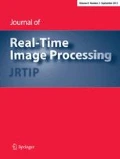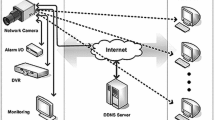Abstract
In real-time image and video processing boards, power, speed, and area are the most often used measures for determining the performance of motion imagery applications. Due to technological advancement, power consumption has gained major attention in real-time image processing ability compared to speed. The increase in on-chip temperature due to larger power consumption has resulted in reduced operating life of chip and battery-driven devices. In this work, a new logic family has been introduced i.e., dual-mode logic (DML), which provides flexibility between the optimization of energy and delay (E-D optimization). This gate can be switched between two modes of operation that is a static mode (CMOS-like mode), which provides low power consumption and dynamic mode, which provides high speed. Recently, power leakage has become a dominant problem due to continuous data transfer among a large number of connected devices. Thus, to reduce power leakage, a self-controllable voltage level (SVL) power reduction technique is used along with DML logic. In the SVL technique, a maximum dc voltage is provided to the active load circuit on-demand or decrease the dc supplied to the load circuit in the standby mode. Integrating DML with the SVL technique reduces power consumption as well as leakage power. A 4-bit RCA, 8-bit RCA, and 16-bit RCA are used for verifying the proposed method and comparison of performance parameters is done with a conventional circuit. Complete circuit implementation and simulation are carried out in TANNER EDA version 13 tools with operating voltage of 1 V. The proposed system is further applied to real-time image, and we obtain the finest resolution level with minimum power consumption.















Similar content being viewed by others
References
Ahmad, A., Anisetti, M., Damiani, E., Jeon, G.: Special issue on real-time image and video processing in mobile embedded systems. J. Real-Time Image Proc. 16(1), 1–4 (2018). https://doi.org/10.1007/s11554-018-0842-4
Monteiro, H. A. et al. (2017). Energy Consumption Measurement of a FPGA Full-HD Video Processing Platform. In Proceedings of 7th Workshop on Circuits and Systems Design (WCAS’17), Fortaleza, Brazil.
Wang, D., Zhu, D., & Liu, R. (2019). Video SAR High-speed Processing Technology Based on FPGA. In 2019 IEEE MTT-S International Microwave Biomedical Conference (IMBioC), Vol. 1, pp. 1–4. IEEE.
Wu, J. (2004). CMOS transistor design challenges for mobile and digital consumer applications. In Proceedings. 7th International Conference on Solid-State and Integrated Circuits Technology, Vol. 1, pp. 90–95. IEEE.
Blanco-Filgueira, B., García-Lesta, D., Fernández-Sanjurjo, M., Brea, V. M., & López, P. (2019). Deep learning-based multiple object visual tracking on embedded system for iot and mobile edge computing applications. IEEE Internet of Things Journal.
Guduri, M., Dokania, V., Verma, R., Islam, A.: Minimum energy solution for ultra-low power applications. Microsyst. Technol. 25(5), 1823–1831 (2019)
Markovic, D., Wang, C.C., Alarcon, L.P., Liu, T.T., Rabaey, J.M.: Ultralow-power design in near-threshold region. Proc. IEEE 98(2), 237–252 (2010)
Hussain, I., Singh, A., & Chaudhury, S. (2018). A Review on the Effects of Technology on CMOS and CPL Logic Style on Performance, Speed and Power Dissipation. In 2018 IEEE Electron Devices Kolkata Conference (EDKCON), pp. 332–336, IEEE.
Baker, R. J. (2019). CMOS: circuit design, layout, and simulation. Wiley-IEEE press.
Garg, S., Gupta, T.K.: Low power domino logic circuits in deep-submicron technology using CMOS. Engineering Science and Technology, an International Journal 21(4), 625–638 (2018)
Kaizerman, A., Fisher, S., & Fish, A. (2012). Subthreshold dual mode logic. IEEE Transactions on Very Large Scale Integration (VLSI) Systems, 21(5), 979–983.
Levi, I., Fish, A.: Dual mode logic—Design for energy efficiency and high performance. IEEE access 1, 258–265 (2013)
Jain, D. K., Jacob, S., Alzubi, J., & Menon, V. (2019). An efficient and adaptable multimedia system for converting PAL to VGA in real-time video processing. Journal of Real-Time Image Processing, 1–13.
Alzubi, J., Jacob, S., Menon, V. G., Joseph, S., & Vinoj, P. G. (2018). A top-up design for pal to vga conversion in real time video processing system. In 2018 International Symposium on Advanced Electrical and Communication Technologies (ISAECT) (pp. 1–5). IEEE.
Garcia, P., Bhowmik, D., Stewart, R., Michaelson, G., Wallace, A.: Optimized Memory Allocation and Power Minimization for FPGA-Based Image Processing. Journal of Imaging. 5(1), 7 (2019)
Kechiche, L., Touil, L., Ouni, B.: Toward the Implementation of an ASIC-Like System on FPGA for Real-Time Video Processing with Power Reduction. International Journal of Reconfigurable Computing. 2018, 1–11 (2018)
Mutoh, S.I., Douseki, T., Matsuya, Y., Aoki, T., Shigematsu, S., Yamada, J.: 1-V power supply high-speed digital circuit technology with multithreshold-voltage CMOS. IEEE J. Solid-State Circuits 30(8), 847–854 (1995)
Kuroda, T., Fujita, T., Mita, S., Nagamatsu, T., Yoshioka, S., Suzuki, K., & Kinugawa, M. (1996). A 0.9-V, 150-MHz, 10-mW, 4 mm/sup 2/, 2-D discrete cosine transform core processor with variable threshold-voltage (VT) scheme. IEEE Journal of Solid-State Circuits, 31(11), 1770–1779.
Balamurugan, V. (2015, March). Performance analysis of asynchronous dual mode logic using leakage power reduction techniques. In 2015 International Conference on Innovations in Information, Embedded and Communication Systems (ICIIECS) (pp. 1–5). IEEE.
Enomoto, T., Oka, Y., Shikano, H.: A self-controllable voltage level (SVL) circuit and its low-power high-speed CMOS circuit applications. IEEE J. Solid-State Circuits 38(7), 1220–1226 (2003)
Akashe, S., Sharma, R., Tiwari, N., & Pandey, R. (2012). Modelling of high speed low power decoder in nanometer era. In 2012 World Congress on Information and Communication Technologies (pp. 13–17). IEEE.
Drazdziulis, M., & Larsson-Edefors, P. (2003). A gate leakage reduction strategy for future CMOS circuits. In ESSCIRC 2004–29th European Solid-State Circuits Conference (pp. 317–320). IEEE.
Müller, H., Unay, D.: Retrieval from and understanding of large-scale multi-modal medical datasets: A review. IEEE Transactions on Multimedia 19(9), 2093–2104 (2017)
Acknowledgement
Authors would like to thank Dr. Mohammad Khosravi, Department of Computer Engineering, Persian Gulf University, Bushehr, Iran for his valuable inputs that has substantially helped in revising and improving the research paper.
Author information
Authors and Affiliations
Corresponding author
Additional information
Publisher's Note
Springer Nature remains neutral with regard to jurisdictional claims in published maps and institutional affiliations.
Rights and permissions
About this article
Cite this article
Jacob, S., Menon, V.G., Joseph, S. et al. Dual-mode power reduction technique for real-time image and video processing board. J Real-Time Image Proc 17, 1991–2004 (2020). https://doi.org/10.1007/s11554-020-00992-x
Received:
Accepted:
Published:
Issue Date:
DOI: https://doi.org/10.1007/s11554-020-00992-x




